 Our permaculture garden has made great progress since we first started back in 2012.
Our permaculture garden has made great progress since we first started back in 2012.
Looking out through my bedroom window at my back garden this morning reminded me that it is time to do an update.
In this photo you see the back garden, a south-facing area comprises about a third of the whole site.
When we first moved in the whole place was a complete wilderness of tangled briar, thistle and scutch grass, old swings and bikes etc.
There has been a lot of progress and hard work since then.
GROWING THE PERMACULTURE GARDEN
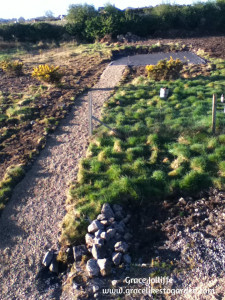 The photograph to the left was taken in 2013 as we set about having my writer’s hut built.
The photograph to the left was taken in 2013 as we set about having my writer’s hut built.
A path was dug out and gravelled and at the back, you can see the foundation of my writer’s hut.
Once these tasks were complete I set about creating a garden in the area you see to the right of the path.
I learned a little about permaculture through reading and attending workshops and was eager to create a permaculture garden.
As always with these things, the land dictates.
Our job was much more difficult than we expected because when we cleared away the briar and overgrowth we discovered that what lay beneath was simply rocks – tons and tons of rocks, some of them as big as tables with little or no soil.
We live close to the Burren which is famous for its limestone flags and rocks and our land has its share of both.
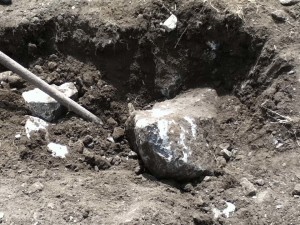 HOW TO MAKE YOUR OWN SOIL
HOW TO MAKE YOUR OWN SOIL
It would have taken 10-15 lorry loads of topsoil to cover this area of our back garden so instead, we decided to go the permaculture route and created our own compost.
We built it up directly in the areas where we wanted it and letting nature take care of the rest.
First, we laid down these materials one on top of the other in the following order:
1. Compostable kitchen waste.
2. Wet newspapers
3. Cardboard saved and collected from neighbours then soaked in water.
4. Seaweed – collected from our nearby bay.
5. Chicken Manure – free, courtesy of our hens.
6. Horse manure – obtained free from local horse owners.
We repeated the above method – creating one bed at a time.
We then allowed our free ranging hens to do their little dance in and around the beds, which they did happily while adding their own valuable poo and further obliging us by mixing it into the beds as they danced.
There may be better ways of doing this but we decided to use what was freely available to us in our surroundings and so far this method has worked.
By the way, we have really enjoyed having hens and fresh eggs are a joy. If you are interested in poultry you can read more hens, ducks and all things fowl here.
We left our newly created beds alone and let nature do its thing over winter.
By the following spring the frost, wind, rains and hens had broken down the materials enough to plant.
After that, we just topped up the beds with a little bit of compost and when it was ready we decided on a loose plan (all our plans are loose) to divide the back garden into four parts.
1. The writer’s hut flower garden.
2. The soft fruit garden.
3. The rose garden.
4. The vegetable garden (nearest the house)
THE WRITERS HUT GARDEN
The writer’s hut is where I write my fiction.
The hut faces down on to the Burren hills which is great to stare at when I am lost for words.
This garden has two wooden raised beds and we used rocks to make two other beds.
We planted a mixture of flowers and herbs in the raised beds and in the other two we sowed wildflower seeds.
The lovely Honesty, with its beautiful seed pods, has become prolific and is self-seeding everywhere – including in the gravel paths.
We also grew some dogwood from canes and placed that and some other shrubs in behind the raised beds to try and create a little shelter from the west wind.
THE SOFT FRUIT GARDEN
Just below the writer’s hut, and bordering the chicken enclosure is the soft fruit garden.
We created beds here using the above method and it has been very successful.
This now has raspberries, loganberries, blackcurrants, gooseberries, redcurrants, rhubarb and tayberries.
The most successful plant has been the raspberry – it provides a huge crop of delicious berries.
The raspberries provide a delicious snack to eat on the go as we work in the garden and I also make jam – lots and lots of raspberry jam.
It also creates many new raspberry plants – too many as they threaten to overgrow our paths, so we dig them out and place them in the areas of the garden which we have left to go wild.
THE ROSE GARDEN
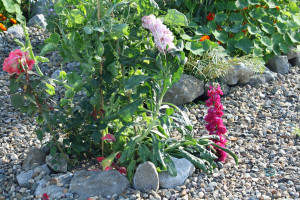 Next, we wanted to create a peaceful and beautiful place to simply sit, think and rest.
Next, we wanted to create a peaceful and beautiful place to simply sit, think and rest.
So third garden we created was a rose and flower garden.
Again we were faced with a lack of soil and so created our own using the above method.
We also made use of our ever-increasing supply of rocks to make some rocky circles for the beds.
I have a bit of thing for circles in the garden. I love the fact that we can use the rocks to create gentle edging as well as a variety of different shapes.
The rose garden is near the chicken enclosure so it is very easy to get plenty of manure for the roses and they do thrive on that.
THE VEGETABLE GARDEN
The vegetable garden has proved to be a lovely manageable place for me to work in and has been very productive – providing nearly all our vegetables and salads in the summer.
I save money and make use of what is freely available to me by making my own nettle tea to feed all my plants with – you can learn how I do that here.
My dream is to one day grow enough vegetables not to have to buy any at all but for this, I would need to start some new beds and I can barely cope with the ones I have.
I don’t work full time in the garden as I work on my fiction writing every day so most of my garden work is confined to evenings and weekends.
SLEEPING WITH THE DISHES
There is already a wooden fence around the vegetable garden which was originally put there to stop me falling down the slope as I have had some mobility/balance issues.
Recently I had to add chicken wire fencing to protect the vegetables from our cabbage/chard/broccoli loving hens.
I tried to get the hens to observe the 80:20 rule and eat only 20% leaving 80% for us but there was no joy. Hens do what hens do…
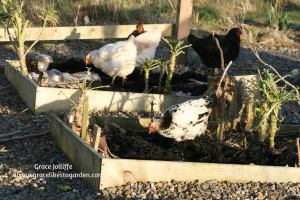 In fact, the greedy little cluckers wanted 100%
In fact, the greedy little cluckers wanted 100%
I learned this the hard way when I returned home one day to find every single kale and chard plant reduced to stringy stalks.
Meanwhile, my happy hens were lolling about giving themselves baths in the baby spinach plants they had just destroyed.
It’s a good job their eggs are so good or I’d be introducing them to the roasting dish…
MORE SOIL
I hope to solve the greedy hen problem next year by marking off a large area where I grow food just for the hens.
The problem is that is a lot of work in itself as first I have to create the soil, then I have to build a fence around it to protect the young plants to give them a chance….
If I am organised enough I should start it after Christmas because the neighbours always have loads of cardboard for me after Father Christmas has been.
The frosty weather will help break it down. It’s on the to-do list so fingers crossed I get there… one day!
In the meantime, the photographs below give a good indication of the progress since 2012 and everything you see is growing in our homemade soil.
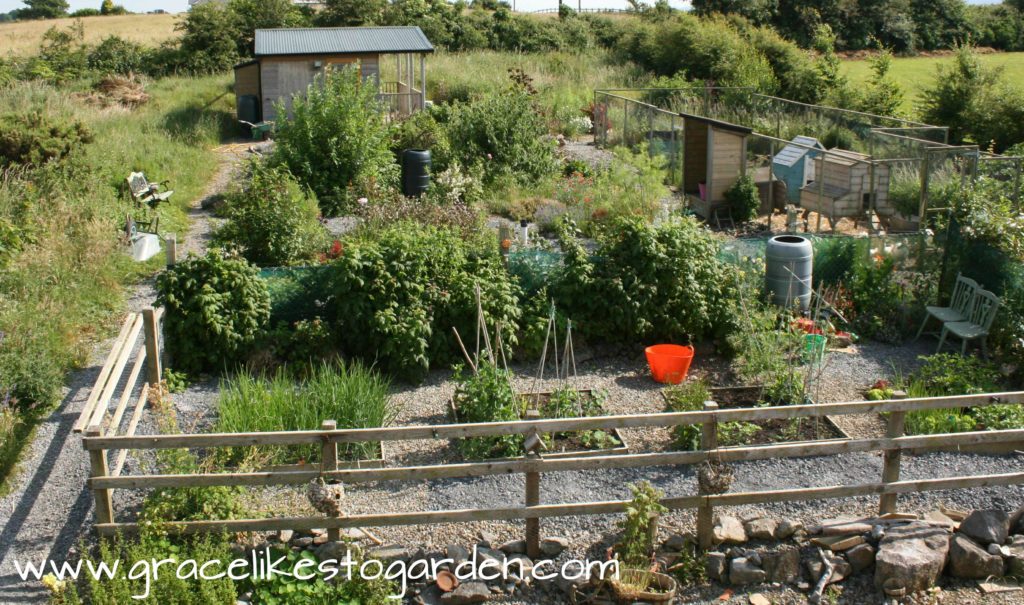 This photo above was taken recently in 2018. As you can see the growth from 2012 to today 2018 has been amazing and proved that the permaculture method did work.
This photo above was taken recently in 2018. As you can see the growth from 2012 to today 2018 has been amazing and proved that the permaculture method did work.
The fence you see separating the vegetable garden from the rest was planted with raspberry bushes so I can pick and eat as I work on the veg.
I hope this has inspired you to try some of the permaculture methods and if you would like to learn more here is a FREE 21 card set of the original permaculture ethics and principles from Brett Pritchard.
Back soon.
Grace
P.S. Please read on to learn about my work in encouraging children to love nature.
BALLYYAHOO
ENCOURAGE YOUR CHILDREN TO LOVE NATURE
As well as gardening I love to write.
I write mainly for adults, but I also used to write for Ireland’s RTE 1 children’s radio stories and still love writing for children.
My Ballyyahoo children’s books are my favourite personal project and my main aim is to share my love of nature with children.
Each book in the series is linked to the Ballyyahoo website with additional information and nature photographs.
There’s so much to love about nature – best of all it’s free!









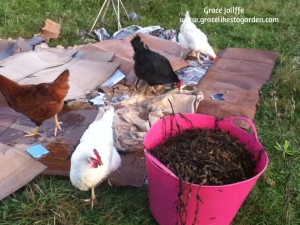

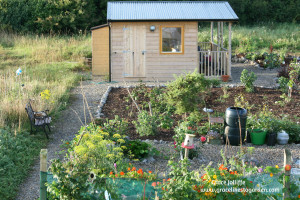

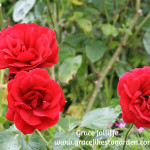



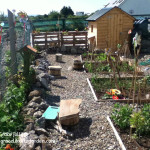

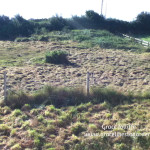
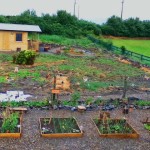
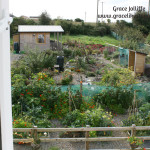

Recent Comments